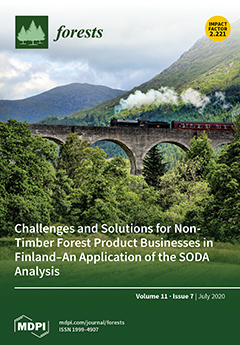Short-rotation forestry is of interest to provide biomass for bioenergy and act as a carbon sink to mitigate global warming. The Poplar tree (
Populus × xiaohei) is a fast-growing and high-yielding tree species in Northeast China. In this study, a total of 128
Populus × xiaohei trees from the Songnen Plain, Heilongjiang Province, Northeastern China, were harvested. Several available independent variables, such as tree diameter at breast height (
D), tree’s total height (
H), crown width (
CW), and crown length (
CL), were differently combined to develop three additive biomass model systems and eight stem volume models for
Populus × xiaohei tree. Variance explained within the three additive biomass model systems ranged from 83% to 98%, which was lowest for the foliage models, and highest for the stem biomass models. Similar findings were found in the stem volume models, in which the models explained more than 94% of the variance. The additional predictors, such as
H,
CL, or
CW, evidently enhanced the model fitting and performance for the total and components biomass along with the stem volume models. Furthermore, the biomass conversion and expansion factors (
BCEFs) of the root (118.2 kg/m
3), stem (380.2 kg/m
3), branch (90.7 kg/m
3), and foliage (31.2 kg/m
3) were also calculated. The carbon concentrations of
Populus × xiaohei in root, stem, branch, and foliage components were 45.98%, 47.74%, 48.32%, and 48.46%, respectively. Overall, the newly established models in this study provided complete and comprehensive tools for quantifying the biomass and stem volume of
Populus × xiaohei, which might be essential to be specifically utilized in the Chinese National Forest Inventory.
Full article





